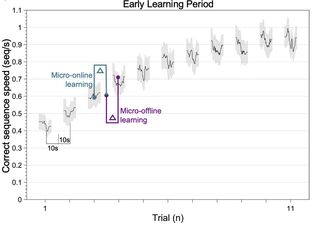Education
How Does "Muscle Memory" Work?
Why taking breaks speeds learning.
Posted June 24, 2021 Reviewed by Jessica Schrader
Key points
- Muscle memory refers to developing a new skill through practice.
- A recent study shows that interspersing short breaks between repetitions encodes skill memories better than back-to-back practice sessions.
- The study also found that instant replay between practice sessions flashes extremely rapidly through the brain.
Building “muscle memory,” that is, developing a new skill through practice, does not work the way you probably believe, according to a new study published in the June 8 issue of Cell Reports. You’ve no doubt had the frustrating experience in learning a new skill, that you continue to flub up even though you make repeated attempts over and over. Yet, if you put the challenge aside for a bit and come back to it later, you find that you are now much more proficient. In learning a new skill, it turns out that the breaks between repetitions are where the action is. By monitoring how neural activity in the brain changes during learning a new skill, researchers report that mental “instant replay” after each performance is critical to perfecting the skill. Moreover, these mental flashbacks have been missed by scientists previously for a surprising reason.
You can practice a difficult piece of music at the piano over and over again, but the enduring memory to execute that performance is not laid down while you are tickling the ivories. Learning begins after you lift your fingers off the keys and take five. New research monitoring brain activity reveals that the same neural networks that are coordinately activated during a practice session automatically replay the same sequence mentally during the breaks between repetitions. This accounts for why interspersing short breaks between repetitions encodes skill memories much better than doggedly repeating the same number of practice sessions back-to-back.
Why, then, is this essential post-performance mental rehearsal not obvious to us as we struggle to learn a new skill? It turns out that the “mental instant replay” flashes through the brain at warp speed—20 times faster than the original experience.
In this new study, the experimental participants were tasked with typing a sequence of five numbers displayed on a computer screen as quickly as possible. To make the task more challenging, the test subjects were required to type the sequence of numbers with their left hand if they were right-handed (and vice versa), using their pinky to type the first number, their ring finger to type the second, their middle finger to type the third, and their index finger to type the fourth number. Using thumbs was not allowed so the pinky typed the fifth digit. This task is not unlike a guitarist learning to accurately manipulate the correct fingers on his/her left hand as they learn to play a new guitar lead solo. The participants were given 10-second trials, interspersed with 10-second rests, and asked to type the sequence of numbers as fast and as accurately as possible during each 10-second practice period. Naturally, their skill improved with each trial so that by the 36th round, they could tap out the sequence correctly in a flash and with much less conscious effort than at first.
The researchers used magnetoencephalography (MEG) to monitor brain activity. MEG works much like the more familiar EEG that detects the brain’s electrical activity through an array of electrodes on the scalp, but MEG detects the magnetic component of the brain’s electromagnetic responses instead of the electrical component. Magnetic fields pass through the brain and skull with much less distortion than electric fields, which follow the path of least resistance through tissue, so MEG enables researchers to better pinpoint where neural activity is flowing inside the brain. In this study, 275 magnetic sensors positioned all over the scalp enabled researchers to identify the location of electrically active circuits in the brain with great precision.
Without any fancy instrumentation, a tell-tale clue in the data tipped off researchers about how the brain was learning this new skill. By simply measuring how much the performance improved during the 36 training sessions, it was clear that skill increased in a step-wise manner with each repetition getting a bit better than the previous one. That is, speed and accuracy did not increase during each 10-second practice session; it ratcheted up after each 10-second rest period, so that performance was incrementally better in the next trial session. Clearly, the improvement was the result of whatever the brain was doing during the rest periods.

The full neural activity sequence detected by MEG during each trial session was replayed in the brain during each 10-second rest period, but the instant replays zipped through the brain 20 times faster than in the live performance. The neural activity screamed through parts of the brain known to be important for memory and motor skill, notably in the hippocampus and sensorimotor cortex, among other regions.
By comparing how improvement in this skill correlated with the speed of the mental flashbacks during rest periods, the researchers found that as the rate of mental replays increased over the 36 training sessions, so too did the actual skill of typing out the sequence improve proportionately. No need for a recital—researchers could predict how well a subject could perform simply by measuring how rapidly the mental instant replay flowed through their brain.
The fact that learning is improved by providing rest intervals as opposed to slogging away with the same number of practices back-to-back has been well established. So too is the importance of sleep in improving enduring memories and in learning new skills well documented. In animal experiments, it has been shown that rats learning to negotiate a new maze replay the experience in their brain activity during sleep, and this consolidates the experience into memory. But now we know that a similar process takes place very rapidly while we are awake in the intervals between practicing. This new study provides a new understanding at the level of brain function of why taking breaks for off-line mental processing is necessary for learning, and it adds the important finding that instant replay between practice sessions flashes extremely rapidly through the brain. All of this was easily missed previously, because mental replay at 20 times normal speed is much too fast for mental imagery to play out as a conscious mental rehearsal.
So “take it again from the top,” but really, it is chilling between bars that lays down the tracks in your brain.
LinkedIn image: Rawpixel.com/Shutterstock


